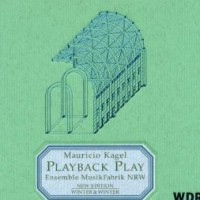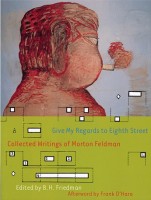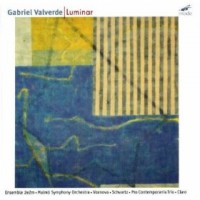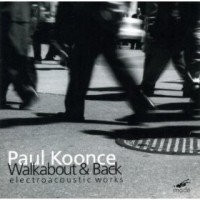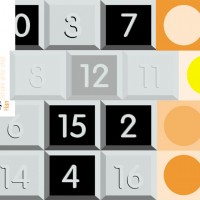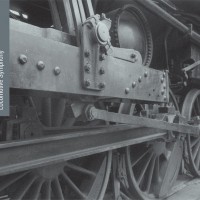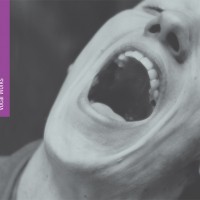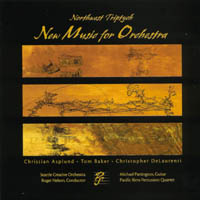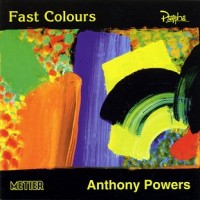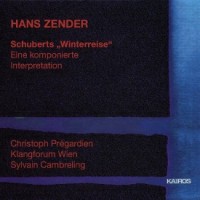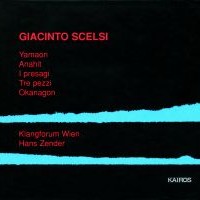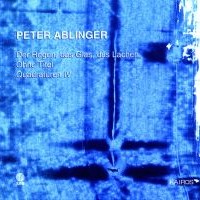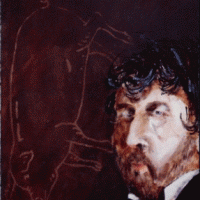Recordings of new and recent music
|
Grant Chu Covell [August 2001. Originally appeared in La Folia 3:4.] Mauricio KAGEL: Playback Play – News from the Music Fair – Radio Piece (1996/97). Ensemble MusikFabrik NRW. Winter & Winter 910 059-2. Distributed in the US by Allegro. This is quintessential Mauricio Kagel, meaning that this disc will amuse Kagel fans and really, really annoy Kagel detractors. Charmed by his first experience of a music fair (a convention where closely spaced booths are simultaneously demonstrating different music products), Kagel constructed this 41-minute work, a “kaleidoscope” where “ different situations unexpectedly succeed one another and coexist simultaneously.” The work is a radio piece which means it is meant to be heard as if over the radio and thus not necessarily in a performance with live musicians. Part of the work is how live and taped sounds commingle, as at a music fair or an exposition, and how without seeing musicians or what is going on, you’re supposed to create your own memory of a music fair. Right off the top, the musicians of a varied chamber ensemble are introduced by Kagel himself, adopting the style of an anonymous announcer over loudspeakers (it’s different from the effect used by Berio in Sinfonia, as Kagel’s intention is not to address the audience, but use the association of the loudspeakers to create an atmosphere). Crowd noise and polite applause interrupt occasionally, and the music rambles halfheartedly through different genres (someone practicing arpeggios, canned rhythms from a keyboard, etc.). The colorful booklet offers an indication of some of the actual music the musicians play, and it appears to be mostly improvised tonal melodies but with precisely notated rhythms. Towards the end there is an extended bit of comedy that will delight Kagel fans (and definitely annoy Kagel haters): Kagel croons a melodramatic (bathetic?) folksong over an out of tune piano accompaniment. I’m a big Kagel fan, but this work is almost too much for me. I’m sure lots of composers and musicians have had the urge to put something like this together (I know I have), but Kagel has the chutzpah and credentials to actually pull it off. And get it performed, recorded, and distributed. Kagel fans have to pick this one up, but all others should keep their blood pressure down and stay away. As always, Winter & Winter has produced a very attractive package, and the sound is well focussed (this is a radio piece after all). The musicians of the Ensemble MusicFabrik are to be commended, and are probably glad that owners of this disc will know exactly how to pronounce their names. Give My Regards to Eighth Street: Collected Writings of Morton Feldman. Edited by B.H. Friedman. Afterword by Frank O’Hara. Exact Change (Cambridge, MA). http://www.exactchange.com/. A must-have book not just for fans of the Cage and Feldman scene, but also for those interested in the visual artists of the 1950’s. Feldman’s circle included Guston, Rauchenberg, Rothko, de Kooning, and others active in New York in the 50s, and these artists greatly influenced his musical philosophy. Here in Feldman’s own words — witty, cutting, yet consistently thought out demonstrating his breadth of knowledge from philosophy to rugs — are revelations into his conception of art and music and all sorts of other things in between distributed among program notes, essays on painters, and assorted other writings. Lots of folks are stuck with the notion that Feldman wrote indeterminate and chance music. Sure Feldman started out this way, but by 1958 Feldman gave up the indeterminacy of graph paper for conventionally notated fixed pitches and rhythms. There are others who know Feldman as the guy who wrote impossibly long pieces like the Second String Quartet, which clocks in around six hours (yes, the number between five and seven), and dismiss him as a tedious crank. But those of us who know Feldman’s music and snap up new recordings as they come out (e.g., the remarkable series on HatART), know better that Feldman is a composer of some of the last century’s most delicate works, even if some of them are long and challenge us to think about time and how music and time work together. Feldman’s thinking is provoking and reassuring, like the words of a famous old uncle who eggs you on to new ideas and experiences. Many Feldman fans already have this collection. Earlier this year, at Louis Goldstein’s transcendent performance of Feldman’s Triadic Memories at Jordan Hall in Boston, I counted several copies proudly flaunted by their owners in the audience. It’s those who think they understand music of last century who really need to read this, especially those who don’t quite yet get Feldman’s genius. The book is available from Exact Change directly at http://www.exactchange.com/ (I got mine from http://www.anomalousrecords.com/ ). Get your local bookseller to stock this and some of their other titles: they publish some key Dada and Surrealist texts like Raymond Roussel’s How I Wrote Certain of My Books and Alfred Jarry’s The Supermale. Oh yeah, they also put out a book by Cage, Composition in Retrospect, too. Gabriel VALVERDE: Espacios Inasibles; Resplandor de los Surem; Terra Incognita; El Silencio ya no es al Silencio; 5000 Voces. Malmö Symphony Orchestra, Arvo Volmer; Haydée Schvartz, piano; Pro Contemporania Trio; Sofia Asunción Claro, harp; Marie Kobayashi, mezzo-soprano, Choir Voxnova, Ensemble 2e2m, Olivier Cuendet, conductor. Mode 94. Mode Records, PO Box 1262, New York, NY 10009, USA. http://www.mode.com/ Gabriel Valverde is a composer of quiet music. I’m talking about a restful sometimes fidgety quiet that will that will draw you in and focus your attention on areas that seem less active. Valverde’s quiet isn’t minimal and won’t invoke trances. There is great energy in this music, and Valverde has a confident voice. The first work on this Mode disc (Mode 94) is a grand two movement work for orchestra, Espacios Inasibles, that relinquishes great activity as if seen from a distance, perhaps even fixed at a distance with no hope of a close-up. In fact, I imagine much of Valverde’s music like looking down at the street from atop a high building, or trying to understand something in a background of a painting. Valverde’s titles do invite comparison to the metaphor of perception and space, quiet and non-quiet: Resplandor de los Surem (The light of the Surem), El Silencio ya no es al Silencio (Silence is no longer merely silence) and Terra Incognita. Valverde has a wonderful orchestral palette full of subtle shadings, using percussion to support a texture or generating brief gestures in winds to give poise and balance. The longish 5000 Voices, for mezzo, chamber choir and ensemble, seems like an extended work of chamber music, though it is for moderately large forces. Terra Incognita, for string trio and tape, lacks the aggressiveness that other composers fall into when mixing strings with tape and may seem less interesting by comparison. But in the context of the rest of the disc, you will hear separate contrasting episodes, the tape acting as a catalyst. The two solo works on the disc are subtle and reflexive: El Silencio ya no es al Silencio, for solo harp has a slack pulse and stutters gently forward. Resplandor de los Surem for piano solo is expansive. A wide range of performers are represented here, from the Malmö Symphony of Sweden to the French Ensemble 2e2m. Clearly Valverde has established a great rapport with some excellent performers and ensembles. This disc is not for those who think new music should be about noise and violence. Valverde brings a gentleness to the world which is surely lacking. PAUL KOONCE: Walkabout; Hothouse; The Flywheel Dream; Pins. Mode 90. Mode Records, PO Box 1262, New York, NY 10009, USA. http://www.mode.com/. From the gentle cough that opens Walkabout, I was entranced and absorbed by this wonderful CD of electroacoustic music from Mode (Mode 90). Paul Koonce’s electroacoustic works are collage-like journeys, some more hallucinatory or dreamlike than others, but all are delicately and intricately constructed. An electric guitar will effortlessly merge into the nasal twang of a singer. A bell sound will seem at first to be from a pinball machine when it’s actually an office telephone. The sound of water dripping becomes the click of an electronic relay. Like the best Dadaist or Surrealist, Koonce works magic with common trinkets, arranging them assuredly in a distinctive and captivating way. In Koonce’s world, sounds dissolve into other sounds, triggering a richness of associations. Often the same sound will change just slightly, yet its relation to other sounds will dramatically change its associations. In just the first 50 seconds of Walkabout, I count but two clearly differentiable source sounds besides the opening cough which float by and intertwine. Masterly variable use of pitch, panning and dynamic are employed upon a klaxon variety car horn and an electric violin sound. The violin sound migrates from single pitches into what sounds to me like a greatly truncated gesture from a well-known Scarlatti Sonata (the E Major one that’s heavily anthologized and which Lucas Foss also used in his Baroque Variations). Clever and charming contrasts are all over this disc: A polka breaks out in Pins, and elsewhere a jazz combo fades out over a manual typewriter. Sounds from the natural world are kept to the fore in Koonce’s work. The touch of the computer is clearly evident in the work’s processing and gentle distortion (reverb, smoothing, mixing, layering, spatialization), but sounds which originate from the computer itself seem rare. Throughout Koonce’s music on this CD, there are a few tricks tossed in to remind us we’re just listening: The slowing down sound an LP makes when you stop it with your fingers, spoofs of the “A” an orchestra uses to tune up, and recording of real instruments playing klangfarbenmelodie. An extended section in The Flywheel Dream blurs the idea that this might just be recorded music, or that maybe it’s constructed to sound like recorded music: Is that a recording of a vibraphone towards the end? But there’s no way the repeated pitches could jump from right to left in real life, so it must be a constructed recording of a vibraphone. Koonce also writes darn well about his own music, and the opener of the booklet sets the stage: “Have you ever experienced those remarkable moments when everyday sounds, similar in structure but different in function, coincide – the phone that rings through the trill of a Mozart piano cadence; the baby whose cry follows the meandering squeak of a nearby door? The coincidence of similar sounds creates curious double takes that draw us back to our senses and into the intrinsic beauty of sound. I am struck by these moments, by their suspension of communication, and by how I find myself listening, uncertain whether I should.” In all, this is capricious and clever music. I’m eager to hear more of Koonce’s electroacoustic work, perhaps Mode will reward us in the coming years. Coming out later this summer Mode has a 2-CD set of electroacoustic works from Xenakis’ CCMIX studio in Paris featuring lots of composers (Xenakis, Risset, Pape, et al.). Gyula CSAPÓ: Handshake after Shot. Budapest Music Center Records BMC CD 013. http://www.bmcrecords.hu/. Distributed in the US by Qualiton. So much new music is written without regard to the space it will be performed in, a potential audience (appreciative or otherwise), or that the very fact a piece of new music is performed in a space for an audience is somehow anachronistic or full of historical significance. This is not the case with the music of Gyula Csapó, judging from the five varied works on this disc. I’m hesitant to call these works theatrical, since that connotes non-musical distractions, and is an adjective often plastered on the works of second rate composers and musicians. But Csapó’s work is theatrical in that his music grapples with the issues that a performance only has meaning in a context, a context of space, audience, or what comes before or after in a performance or the historical context of the piece. Regardless, Csapó’s music sounds nice too: It is always a relief that regardless of the extra-musical connotations and intentions that the music itself is interesting to listen to. Hard, Edvard — hommage à Grieg, for two dulcimers, piano and contrabass encourages us to reconsider Grieg over its nearly twenty minute unbroken span. A string of chords extracted out of context from Grieg’s piano works are irregularly spaced, and there is no melody or interchange of voices. The bass contributes an independent bass line, which enhances and obscures any potential harmonic function the piano chords are supposed to have (Csapó calls this a ring modulator effect). The piano combined with the intrinsically out of tune dulcimers creates a quaint pianola or church basement piano effect, which exactly suits my conception of this aspect of Grieg’s music. Arpeggios appear now and again which confound and regularity. It’s a long and not very varied piece, you could say Csapó deconstructs Grieg, but that’s too easy. As the title suggests, it’s more like an appreciation of Grieg. Krapp’s Last Tape — after Samuel Beckett is Csapó’s take on Beckett’s one-man short play of the same name. Instead of an actor confronting himself on tape, it’s a violinist. Csapó has the violin play simple material whose manipulations are easy to follow. While we don’t get to see the lighting effects which are an integral part of the piece’s theatricality, there is an omnipresent high F# sine tone to remind us that we’re listening. Some effects processing permits the violinist to play against a grainier recording of himself, and there are taped and live effects of sound being sped up and repeated. A detailed program note gives an indication as to what is actually happening. The title work, Handshake After Shot opens the disc. It is an endearing fanfare for two trumpets, an oboe, an electric organ holding two pitches throughout, and someone tapping a cardboard box. The closing work, BirdDayCage, is a tantalizingly brief 71-second birthday tribute to John Cage for cello and piano. László SÁRY: Locomotive Symphony; Studies on Steam Engines. Budapest Music Center Records BMC CD 010. http://www.bmcrecords.hu/. Distributed in the US by Qualiton. [The CD also reissues a 1983 Hungaroton LP (SLPX 19213) of Hungary’s steam engine sounds collected by Zsolt Károlyi.] Dedicated to Sáry’s father–who was a station manager–these two works are composed by someone who knows, loves, and has lived near trains. Locomotive Symphony is the title work and Studies on Steam Engines is its shorter precursor. Both are charming works of musique concrete that revel in the sounds of Hungarian steam locomotives. Sáry’s use of the sources is mostly non-destructive (that is, the original train sounds are almost always recognizable): we hear pitch shifting of whistles and bells, chuffing engines and clanging rails. Sáry’s works are build episodically: a type of sound will be explored for a few minutes, rhythmic patterns will be emphasized, or a contrast will be made between several different types of the same sound such as steam whistles which may gradually change in pitch or be combined. Sáry’s work with trains begs compare with Pierre Schaeffer’s Étude aux chemins de fer (1948 and 1971) so let me get that out of the way. (Étude is on Caipirinnha CAI.2027.2, mentioned by me back in La Folia 2:4, and both versions are on the 3CD Pierre Schaeffer L’Oeuvre Musical on INA GRM 292 572.) Schaeffer’s work focuses upon the intrinsic noisiness of the trains and how their sounds can be transformed into something else, whereas Sáry respects the integrity of the trains, for the most part ordering and organizing pure sounds. Sáry’s achievement is all the more impressive after listening to the 3rd track on the CD, a reissue of a Hungaroton LP of the sounds of Hungarian steam engines. You can hear nearly 45 minutes of Hungarian trains starting, passing, and braking along with some ambient noises, and realize that Sáry has a light touch with his material, extracting richness from the source as well as cleaning out background and environmental noise. Péter Eötvös: Vocal Works Two Monologues; Harakiri; Tale; Insetti Galanti; Cricketmusic. Budapest Music Center Records. BMC CD 038. http://www.bmcrecords.hu/. Distributed in the US by Qualiton. This title of the Vocal Works disc is somewhat of a misnomer, as these are not simply works for voices like choral works, but works requiring voices, and not just human voices. The opening work is extracted from Eötvös’s Chekhov opera, Three Sisters, another work is a bizarre ritual, one is for chorus alone, and two are for tape (one with the sound of crickets). Nonetheless, this disc is well balanced and a good way to know the compositions of a leading composer and conductor better. (In case you were wondering, I have it on good authority that “Eötvös” is pronounced like “eut-veush”.) Harakiri will get your attention. It is full of contrasts and also very creepy. Imagine a ritual suicide narrated by a clown in Japanese. Imagine the lines of a fairy tale translated from Hungarian into Japanese being spoken. Imagine two shakuhachi (Japanese flutes) intoning long and lonesome lines that alternately ignore and interact with one another. Furthermore, imagine someone cutting wood during the entire piece, the abrupt sound of wood splitting and pieces of wood clattering to the floor. The recording of Harakiri is from the work’s premiere and conveys the work’s strangeness: microphones pick up foot steps, the pouring of liquids, the irregular and unsetting sound of wood falling to the floor, and other stage action which we cannot see. Oddly, the notes for another disc of Eötvös which I will look at next time refers to this work as a vaudeville: maybe I’m missing something. Tale, for tape, takes elements of traditional Hungarian story telling and tosses them in a blender. The speaker, Proshka Molnàr, has a rich voice, and she recites standard phrases from Hungarian folk tales which are layered to create a work that blurs the meaning of the text with the sounds of the text itself. Cricketmusic is similar to Tale except the sounds of crickets (from a Japanese recording) are the source. The longest work on the disc, Two Monologues, from the opera, Three Sisters, gives a sense of Eötvös’s command and breadth making me want the complete and recent recording in DG’s 20/21 series. Northwest Triptych: New Music for Orchestra: Christian ASPLUND: Symphony No. 4; Tom BAKER: Negative Space; Christopher DELAURENTI: Three Camels for Orchestra. Present Sounds, 1519 1st Ave. W., Seattle, WA 98119. http://www.presentsounds.com/ This is the inaugural release of Present Sounds, a new label dedicated to presenting and promoting work by composers living and working in the Pacific Northwest, is colorful and varied, its three distinctive orchestral works reflect immense potential for this endeavor. Actually, when you think about it, it’s really wonderful that this first release is of orchestral works, a medium for new music that’s often difficult to assemble forces for readings and performances, let alone a full length recording. Good luck to them! The opener is Christian ASPLUND’s Symphony No. 4. Long at almost 34 minutes, Asplund’s essay is episodic and somewhat minimal, reminding me of moments from some of John Adam’s early and large canvases. Except for a wind ensemble opening, percussion dominates, providing the work its underlying force and momentum. Asplund chains together blocks of square sometimes repetitive material, and except for some attempts by the strings, there are few large phrases or sweeping melodies. The percussion section includes lots of paper: the delicate sound of tapped paper bags and someone tearing the pages out of a phone book. I can’t help comparing the work to the last movement of Silvestre Revueltas’ Night of the Mayas, in that both works build link slightly related and gyrating sections together. To my ear, in the Asplund Symphony, the Seattle Creative Orchestra has a slightly coarse sound, especially in the strings. Is it microphone placement or is it the hall? Tom BAKER’s Negative Space is a complete contrast to Asplund’s Symphony. Hesitant and indecisive gestures move slowly without apparent relationship, and the listener is at a loss to consider what is foreground and what is background, hence the title. Baker’s work is full of gentle swells and slow moving textures, clearly he has studied the pages of classic 20th century orchestral works. At around 12:00 to 14:00 there is a wonderfully orchestrated section where winds and strings are meshed in a slow and gradually moving texture that seems to move steadily upward. I’d be happy to hear what he can do with a smaller mixed ensemble. Christopher DeLAURENTI’s Three Camels for Orchestra has the most potential for upsetting and annoying. Three Camels is for orchestra, but it is actually skilled work of musique concrete, a delirious cut and paste of pre-recorded orchestral gestures and snippets assembled ingeniously for maximum effect. Most collage works exist merely to challenge your listening skills against the composer’s, but DeLaurenti’s essay is more about enjoying the resulting concoction than identifying the originals. Technically, DeLaurenti did a great job of mixing the sounds and using slight reverb to give the work a consistent surface, as if it had actually been played in one place by one very large and nimble orchestra. (But, I can’t resist playing Name That Tune. I hear what sounds to me like phrases from Schoenberg’s Op. 16, Webern’s unpublished orchestra pieces of 1913, Berg’s Op. 6, Holst’s The Planets, Ruggles Sun Treader, Wagner’s Ride of the Valkyies as used by Carl Stalling, Gershwin’s Rhapsody in Blue, John Adams’s The Chairman Dances, and some neoclassical Stravinsky.) It seems as if DeLaurenti has created a core set of blocks, as some of the same gestures reappear in each of the movements, though juxtaposed differently. I hear that these blocks are distinct choirs: brass gestures from one work are set over string gestures from another. It is very well done, and like the other works on this disc, reflects great variety and potential. Let me put DeLaurenti into more perspective by talking about a disc he put together before this one. N30 is the name of a self-produced and released disc (you can get it directly from the composer at http://www.delaurenti.net/) with two short pieces and the title work, an hour long audio documentary of the World Trade Organization protests in Seattle in November 1999. N30 breaks into that rare genre of music that tries to provoke thought and action by collating and assembling the noises and voices of protest. In one level, it is a political statement demonstrating what a composer can do to influence others and participate in social change (ok, so I’ve been reading some of Hanns Eisler’s essays). On the other hand, it is a convincing audio documentary that captures Seattle on the 30 November 1999. It’s hard to imagine listening to an hour of protest sounds, but the combination of ambient sounds, voices, chanting and drumming, do make this a worthwhile listen in the same category as the Vancouver Soundscape work from the 1970’s and Glenn Gould’s radiophonic pieces. Anthony POWERS: Fast Colours, Double Sonata, In Sunlight, Quintet, Another part of the island. Psappha. Metier MSV CD92038. Metier Sound & Vision, East End Compoton Abbas, Dorset, SP7 0ND, England. http://www.metierrecords.co.uk. Distributed in the US by Qualiton. No note is out of place in this disc of five chamber works by Anthony POWERS. Powers is a direct and unsentimental composer, and I find his music agile and marked by balanced contrasts. The title piece, Fast Colours, is full of well timed contrasts where one instrument pair plays in one mood and then may be engaged by another pair offering a contrasting flourish. The notes make much of the fact that Powers studied with Nadia Boulanger, one of the most influential teachers of all time who taught many first rate composers and musicians (though there was a point when practically everybody in America claimed to have studied with her). Consequently, there is a clean sense of melodic line, a Boulanger hallmark, and nothing wasteful in this music. A skilled instrumentator, Powers’s small ensembles sound larger than they actually are, especially in the five person Fast Colours. I want to hear some of Powers’ orchestral work, and see how some of his concerns play out for larger forces and time frames. Fine and spirited performances by the Psappha ensemble reveal tight ensemble playing and listening. It sounds as if every note and phrase of Powers’ music is clearly notated and marked as the performers seem to know exactly what to do. The five chamber pieces on this disc are recorded very intimately. Occasionally the clarinet is a hair’s breath of being squawky and the piano sounds slightly too far away, but these realities bring a sense of place to this music. The folks at Kairos have a really neat looking Website at http://www.kairos-music.com/. And their upcoming and current list of releases has many must have items. Ok, I’m partial to the hard-edged European sound and it’s composers, but they got lots of Lachenmann in preparation which I hope I’ll get to talk about here at some later date. Check out these very versatile three items (by the way, for some odd reason, the folks at Berkshire Record Outlet, http://www.broinc.com, also have a lot of their stuff too ). Hans ZENDER: Schubert’s Winterreise, a composed interpretation for tenor and orchestra. Christoph Prégardien, tenor; Klangforum Wien, Sylvian Cambreling. Kairos 00120020KAI (2CDs). Kairos, Feldgasse 15, Vienna, Austria, A-1080. http://www.kairos-music.com/ For several weeks this set earned pride of place and received almost daily play. I could not get enough of Zender’s wonderful “composed interpretation” of Schubert’s Winterreise, and shared it with anyone who’d take the time to sit and listen. This composed interpretation is an act of homage and respect, and it is very evident that Zender loves this piece. This is no mere orchestration: it is a considered version of Schubert’s song cycle recast for tenor and chamber ensemble. Purists are probably affronted already, as Schubert’s original is pretty close to perfection, and some legions of the performance police will insist that Winterreise be imbued with appropriate gravitas. Zender extends Schubert’s hints of sound effects, repeats phrases, adds beats, and intertwines phrases to create new counterpoint. Zender’s small orchestra is extended with percussion (including a wind-machine), guitar, harp and, as we should expect, an accordion. The tenor must occasionally lapse into sprechtstimme, but for the most part sings over the ensemble. From the beginning, Zender makes clear what he is going to do with the Schubert, namely emphasize each song’s key motives through repetition and orchestration. The opening song, Gute Nacht, is expanded greatly and a few minutes pass before the song unfolds properly, from noise into recognizable Schubert. Zender seizes upon the initial descending notes of the vocal line, “Fremd bin ich eingezogen”, which are delicately ghosted by an offstage flute behind Zender’s rescoring of the piano’s left hand for guitar. When the tenor finally joins in, it is exquisite. Scored for strings, a masterly gesture which shockingly recalls Schubert’s late string quartets, the opening verse’s key change at “Das Mädchen sprach von Liebe, die Mutter gar von Eh’,” is remarkable and beautiful. What I found surprising, was how much Zender’s orchestration of a late Schubert work sounds like early Mahler, or, to put it more sensibly, I was surprised to realize how much Mahler’s early songs (Die Knaben Wunderhorn, et al.) rely upon Schubert. Zender is an established conductor and Mahler is in his repertoire, and it’s clear that Zender underscored a connection that was less audible. There is an earlier recording of this work Zender conducting which I have not heard (BMG 09026-68067-2 with Hans Peter Blochwitz, tenor, and the Ensemble Modern). Our editor here and others have written of it disparagingly, and I’m not sure whether that recording’s sound quality or Zender’s orchestration and extreme license has upset them more. In some ways Zender’s “composed interpretation” is for himself alone, a personal amusement and act of homage. I know that this recording demonstrates finesse in balance as there are offstage and almost inaudible melodies and sounds shrouded in the orchestration. The opening of Gute Nacht is a supreme example of a melody played quietly so you cannot quite hear it, unless you are prepared for it by Schubert’s original. Prégardien has amazing diction, clarity and sense, and he is never upstaged or drowned out by the orchestra. Compared to his recording of Schubert’s original for piano and voice (with Andras Staier at a monochrome period fortepiano on Teldec 0630-18824-2), I’ll take this untraditional concoction any day. Giacinto SCELSI: Yamaon; Anahit; I presagi; Tre pezzi; Okanagon. Roland Hermann, bass; Annette Bik, violin; Pierre-Stéphane Meugé, saxophone; Klangforum Wien, Hans Zender, Beat Furrer. Kairos 0012032KAI. Kairos, Feldgasse 15, Vienna, Austria, A-1080. http://www.kairos-music.com/ Here are five very intense Scelsi works, well recorded and played by one of Europe’s best contemporary music ensembles. Yamaon was unknown to me before this disc, but Yamaon is unmistakably Scelsi. Who else would set a Mayan text warning of the destruction of a city? Who else would combine bass voice with alto and tenor saxophone, contrabassoon, percussion and double bass? This recording captures this complex texture incredibly well: the nasal and somewhat vulgar texture of contrabassoon and saxophones is on target, and the double bass’s intonation and timbre is clear amongst the thick din of low instruments. Roland Hermann sings Scelsi’s thick line of vowels and consonants expertly, almost as if it were in fact meaningful in the conventional sense. Anahit has always been a favorite of mine. It almost resembles a violin concerto, but the violin is brutally mistuned as are many of the 18 accompanying instruments. Someone hearing it from the next room might think you were listening to “Best Air Raid Sirens.” Imagine a slow pulse with dissonant violin chords sliding up, down, and through a gradually ebbing and receding texture of unisons and clusters. Scelsi’s orchestration and palette is masterly: with just a few simple notes, emphasizing the dissonance or consonance of an interval, Scelsi spawns a rich and unmistakable texture. Three Pieces for saxophone is surprisingly delicate and mystical. I find the gentle reverb captured during the recording to be a wonderful enhancement to these short, somewhat ritualistic piece. As in most Scelsi, a movement, or an entire area of a work, will be rooted on a certain pitch, and other pitches will caress or bounce off of it, creating an illusion of harmony and playing with our perception of melody and harmony. I presagi is also about the destruction of a Mayan city, but for 10 instruments alone, with an emphasis on the gravelly sounds of low brass. Okanagon is for the bizarre combination of harp, double bass and tam-tam (a large and low pitched gong which can also be played by scraping and tapping, think also of the opening of the last song of Mahler’s Das Lied von der Erde). The harp usually has something rattling the strings like a knitting needle, and the whole work sets everything rattling and vibrating. There is a section of resonant knocking (the body of the harp and the body of the double bass). Hans Zender contributes a strong essay on the reception of Scelsi’s music, dissecting assertions made by those who see Scelsi as only a radical free from tradition. Interestingly, Zender makes it clear that he is at odds with Scelsi’s method of composition (essentially, Scelsi improvised and others created standard notation), but emphatic about the power of Scelsi’s music to communicate. The clarity of timbres, so essential to Scelsi, is made so clear and so evident in this disc, that for Scelsi fans this disc is a must have, even though this disc duplicates other recordings. Recorded in various locations around Vienna (Anahit and I presagi were recorded in the Konzerthaus!), the resonance plays an important rôle and is wonderfully captured here. Peter ABLINGER: Der Regen, das Glas, das Lachen; Ohne Titel; Quadraten IV (“Selbstportait mit Berlin”). Kairos 0012192KAI. Kairos, Feldgasse 15, Vienna, Austria, A-1080. http://www.kairos-music.com/. A cheap derivative of Mark Twain’s quip on Wagner springs immediately to mind: Ablinger’s music should be much better than it sounds. Ignoring Ablinger’s titles and stance, there is something to listen to in his music, but the scale and pacing is frustratingly odd. It’s like watching someone trying to pour water on the floor and he keeps missing. In some of his works, Ablinger is somewhat obsessed with the pitch of B. (Ablinger is the living realization of a running joke I’ve had with C.S. Johnson, a composer who’d like to be known for his use of the pitch of B.) Ablinger repeats the pitch of B much as a nervous person unconsciously jingles the change in his pocket. In some works it’s like the insistent honk of a cabdriver waiting to pick someone up. Music that focuses on one pitch can be fascinating (Scelsi, Vivier, Carter, etc.), but Ablinger seems to be after something else. This music is intentionally static (no, not like radio static). At a macro level, nothing is supposed to happen, but the small level there’s all sorts of stuff that seems to go nowhere. There are no melodies and no signposts. Scale patterns are slowed down, obscuring relationships, and ensembles play chaotically or in steady pulses. Maybe there’s a musica negativa aspect I’m missing (Berg did use the pitch B famously in Wozzeck), but I don’t think there’s a translation problem here. Kairos collects three works for large ensembles in superb performances by the Klangforum Wien under Sylvain Cambreling, which makes this music all the more frustrating as it sounds so good. Just so you don’t think I haven’t done my homework, let me consider some other discs of his (I am really very perplexed by Ablinger). Hat Art offers a somewhat inscrutable piece, the aptly named Grisailles (1 – 100), on hat[now]ART 132, for three pianos played through the use of layered recordings by Hildegard Kleeb. On Peter Ablinger Werke 89-91 (Klangschnitte 4, GE 11 — I got mine from http://www.anomalousrecords.com/ ), there are three works for small ensembles and sometimes tape: one for trombone and 12 cassette recorders, one for trombone and viola, and one for violin tuned like a viola (the work’s titles will not help). The gritty, strained sound of B figures prominently in the work for violin tuned like a viola. The work for trombone and tapes is the most colorful, the combination of trombone and tapes sounds occasionally like a duck and a freight elevator. The most incomprehensible Ablinger work I’ve heard is IEAOV for two trombones and two cellos processed with electronics on the 3 disc set Donaueschinger Musiktage 1997 (col legno WWE 3CD 20026). Perhaps someone out there can clue me in. Harrison Birtwistle by Jonathan Cross. Cornell University Press, Ithaca, New York. There was a time, not too long ago, when I could easily confuse Birtwistle with Ferneyhough. This admission must seem to be one of those wonderfully absurd and abstruse sentences for anyone outside of contemporary music, I mean, from an American perspective they are both funny looking polysyllabic British names. But once you cut across the surface of the music, all parallels are gone. Ferneyhough is the complexity guy who has written much fiendishly difficult music, while Birtwistle is the more approachable and theatrical one whose sound is somewhat reminiscent of late Stravinsky. Jonathan Cross has written a decent little book that gives Birtwistle great context. I like Birtwistle and have several of his CDs, but have never experienced any of his many dramatic works or operas (probably true for most Americans), or have been able to look at large ranges of his works with any perspective. Cross’s book provides a great deal of perspective, concentrating on themes and characteristics that run through Birtwistle’s work: Repetition, theater, ritual, pulse and line, just to name a few. Thankfully, I have more points of entry for Birtwistle and was quite happy that I could hear more when I pulled a few discs off the shelves. My favorite work of Birtwistle’s has been Ritual Fragment (the London Sinfonietta under Oliver Knussen on NMC D009 with Melencolia 1 and Meridian) a short work where instruments from the chamber ensemble move to the front of the stage to play soloist and then retreat to the seat left vacant by the next soloist. This work’s theatrical bent is hard to hear on a recording, but the subtle use of repetition and the way the work seems to undulate and churn, and then retreat or finally and unexpectedly appear near where it started is quite clever. The back cover of the paperback edition claims: “Sir Harrison Birtwistle is the most original, the most challenging and the most controversial British composer of our time.” I dislike such grandiose platitudes, but find even more grating that Cross is allowed to repeat himself within the book. Perhaps an editor missed the intentional repetitions or squelched the conscientious and internal references, but I found them throughout the book. On p. 54 we find a quote of Birtwistle musing about ostinatos and the same quote again on page p. 214. No harm repeating oneself, but this sort of thing will annoy any moderately intelligent reader. Coming up next issue, another disc of Eötvös from Hungary (I’m way partial to Eastern Europe, if you haven’t noticed), the Nono opera (spectacle or debacle?) on Teldec’s new series (which is also supposed to pick up where Sony’s Ligeti series stopped), Crumb and Lansky from Bridge Records, and discs with Rihm, Pintscher and Furrer from Kairos.
Ablinger, Asplund, Baker, Birtwistle, Csapó, DeLaurenti, Eötvös, Feldman, Kagel, Koonce, Powers, Sary, Scelsi, Valverde, Zender
[More Grant Chu Covell, Vol. 3, No. 4]
[More
Ablinger, Asplund, Baker, Birtwistle, Csapó, DeLaurenti, Eötvös, Feldman, Kagel, Koonce, Powers, Sary, Scelsi, Valverde, Zender]
[Previous Article:
The Year’s So Far Best]
[Next Article:
Globalization and the Destruction of Culture]
|
